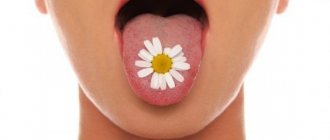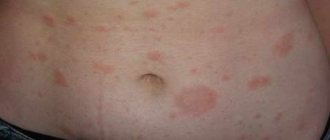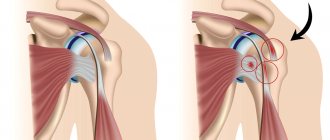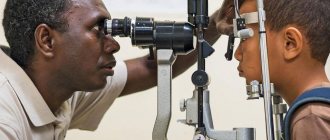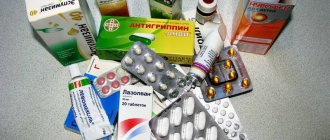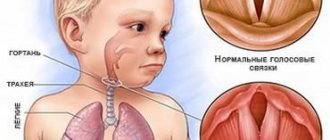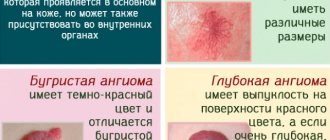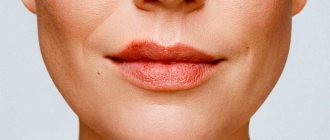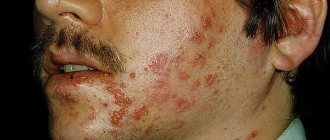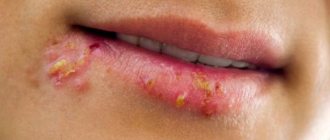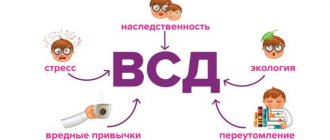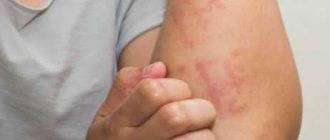Antibacterial agents
Antibacterial drugs do not directly destroy viral particles, however, they can prevent the development of a secondary bacterial infection, as well as speed up regeneration processes.
In this regard, it is recommended to use them at a time when the symptoms of herpes have already decreased, but the risk of additional infection remains. Doctors recommend using these drugs:
- complex therapy for herpes often includes the use of tetracycline ointment. It is applied to already formed crusts that appear after the herpetic blisters burst. It is advisable to use the medication in the form of compresses;
- Levomekol not only has antibacterial activity, but also disinfects the skin and accelerates the regeneration of damaged skin. The average duration of treatment with this remedy is from 7 to 10 days, depending on the severity of the symptoms present.
These effects are also present in zinc ointment, Vishnevsky ointment, fucorcin, oxolinic ointment and sulfur ointment. All of them exhibit a weak antibacterial effect and accelerate tissue repair.
Features of the virus
According to statistics, approximately 67% of the adult population of the planet is infected with Herpes simplex virus type 1 and 11% with type 2. HSV 1 often manifests itself already in infancy as gingivostomatitis. Many mothers, when symptoms appear in their child, think that it is just teething. But symptoms continue to appear, and almost a third of children under 10 years of age have HSV 1. Herpes simplex virus type 2 is associated with sexual activity. More often it is found in people who lead a promiscuous sex life and do not have regular partners.
The main routes of HSV infection are:
- sexual;
- airborne;
- contact;
- domestic;
- transplacental.
Herpes simplex virus is transmitted to a healthy person as a result of contact with utensils, hygiene products, through oral, genital, and vaginal contact. Even a barrier method of contraception does not guarantee one hundred percent protection against infection.
In a humid and moderately warm external environment, HSV can live up to a day, at -70°C - for 5 days. If the temperature rises to +50°C, it is inactivated within half an hour.
IMPORTANT! Initially, Virus simplex infects epithelial cells, and the latent phase of the disease occurs in neurons. There are still no drugs against simplex that can completely destroy it. But drugs have been developed that suppress the action and reproduction of the pathogen, but it cannot be removed from nerve cells.
Acyclovir
It is best to use this ointment immediately after vesicles appear. It is applied to the pouring elements in a thin layer. Acyclovir penetrates epithelial cells, attacks the DNA of the virus and inhibits the replication function. Within half an hour, patients’ condition significantly improves, swelling goes away, and itching disappears. You need to smear the affected areas every three hours, otherwise there will be no desired effect. The duration of treatment is 7-12 days. During this time, crusts form at the site of the rash, which prevent the viral particles from spreading further.
The medicine is not suitable for pregnant and lactating women. This is due to the fact that it actively penetrates the placenta and breast milk.
Among the side effects, an allergic reaction in the form of skin itching is rarely observed.
The cost of the drug is low - only 20-60 rubles.
An analogue of Acyclovir is Zovirax ointment. Its price will be higher - 220-300 rubles.
Treatment of herpes on the body
The patient experiences a general deterioration in his condition, body temperature rises, and the affected areas of the skin hurt. In some cases, disturbances in taste and olfactory sensations are observed, nausea, vomiting, and dizziness occur. Some patients experience fainting conditions that require prompt medical attention.
Treatment for herpes on the body includes the use of special medications, external and internal, and traditional methods of treatment are widely used. Special therapy is prescribed for pregnant and lactating women. The effectiveness of treatment depends on timely diagnosis, stage of the disease, and patient’s condition. The disease is especially difficult with complications in pregnant women, children and the elderly.
It is necessary to take preventive measures in a timely manner to avoid re-infection with the virus. Hardening, good nutrition, proper daily routine, strict adherence to personal hygiene rules, vitamin therapy and other ways to increase immunity will help prevent illness. Monitoring the condition involves taking tests for the presence of the pathogen and, if necessary, medical prescriptions. During illness, it is necessary to observe quarantine and limit any contact with healthy people.
A specialist must conduct an examination of the patient and decipher the results of laboratory tests. For this purpose, you need to consult a therapist. When diagnosing the herpes virus and its variety, he gives a referral to a specialist. Treatment is carried out by a dermatologist or dermatovenerologist if the rash appears on the mucous membranes of the genital organs. If symptoms of the disease appear in the eyes, you should consult an ophthalmologist for appointments.
Tablets for herpes infection
Almost everyone knows what herpes looks like, but not everyone knows how to treat it correctly. Often, when herpes manifests itself, people begin to use various pills. But such treatment is considered incorrect if herpes occurs once or twice a year. Experts recommend taking anti-herpes pills only for severe cases of the disease or for regular relapses.
Drugs for the treatment of herpes are divided into several types. These include the following means.
- Antiviral drugs. In practice, they are called antiherpetic drugs or antiherpes. Antiviral drugs for herpes have an effect that is aimed at blocking the viral process and stopping the activity of the virus. These drugs include those containing acyclovir.
- Means aimed at stimulating the production of interferon in the body. These include Cycloferon, Amiksin, Anaferon, Arbidol. Such drugs against herpes enhance the overall immunity of the body.
- Products containing natural or artificial interferon. They are produced in the form of tablets, like Anaferon and Ergoferon, in the form of suppositories, like Viferon, in powder form, like Antigrippin Agri. Such drugs can suppress viral infection. But a positive result will come only when treatment was started when the first signs appeared.
- Immunostimulating agents of other types. These include Isoprinosin, Galavit, Gepon, Groprinosin. Their action is aimed at instant maturation of leukocytes and enhancing their performance.
Since drugs based on acyclovir are considered more popular, it is worth understanding about its use. How to take acyclovir for herpes? The treatment course lasts from five to ten days, depending on the severity of the disease. During this time, the patient needs to take Acyclovir tablets, two hundred milligrams per dose, up to five times a day. Adults can increase the dosage to four hundred milligrams while reducing the amount taken. To prevent herpes from occurring when immune function is weakened, tablets can be taken as a preventive measure. To do this, the doctor prescribes two hundred milligrams up to four times a day every five to six hours. If herpes appears in children, then treatment with acyclovir is carried out in the same way as in adults.
Doctors also prescribe a drug such as Valaciclovir. This is an effective herpes remedy that is considered safer. But it costs much more than acyclovir-based drugs. When using the drug, Valacyclovir, entering the human body, turns into acyclovir. Has the ability to suppress viruses from the first to the sixth type of herpes. Its action is aimed not only at stopping the reproduction of the virus, but also destroying the affected cells. This property allows you to reduce the number of relapses.
In some situations, doctors prescribe Famciclovir. This drug for herpes is used in severe cases or in those people who suffer from immunodeficiency. It is capable of activity not only against herpes on the lips, but also on other parts of the body. It is able to overcome the reproduction of the Einstein-Barr virus and cytomegalovirus.
Thirty years cannot be fit on one page.
12 January 2009
Author: forum participant Pasha
I’ll try to remember and make a table of my remissions. I first noticed rashes when I was 25 years old. There were small spots on the head, somewhere on the body (I don’t remember). I went to the doctor, was diagnosed with psoriasis, and I found out that it was a chronic disease (sea of tears). They advised me to give up spicy, sweet, fatty foods, and to walk a lot. Treatment consisted of taking vitamins (Dekamevit, and also intramuscularly - Vit. B1, B12, B6) and ointment for the head (made according to a prescription, I don’t remember the composition). Everything passed quickly, and I hoped that this would not happen again. I threw away all the recipes and also forgot about trigger foods.
Three years later, signs of psora appeared again, but only on the body and not much. Again, B vitamins were prescribed at the KVD (I took them at home) and some injections were also given at the KVD (I think hormonal). But then I again reacted somehow irresponsibly to this, did not ask the doctor and did not remember what I was treated with. Remission came quickly, and I forgot about everything.
Three years later there was a rash on my head and one or two plaques on my body, but I was expecting a child and there was no treatment. True, in the maternity hospital they injected me with vitamins B1 and B12 (hemoglobin was low). The head and body cleared up six months after the birth of the child.
Three years later, rashes appeared on the body, legs, elbows, and head (small, but many). I accepted my condition, did nothing, didn’t go to the doctor, didn’t follow any diet. I had all this nonsense for about a year, but it all went away after a vacation in Gelendzhik in October.
And again, after three years (there was always THREE years of remission), plaques appeared again on the head and elbows. I started treatment with Vitamins on my own (it didn’t help), I smeared my head a little with something like grease (I don’t remember what, but it helped for a short time). This time there was no clean body and head for three years.
Then somehow everything went away by itself and the remission lasted again for three years.
And then 12 years - spreading plaques on the buttocks, hips, elbows, stomach, knees, head. Small improvements occurred during a period of rest in the South, where she took mud therapy, sun and sea baths, and some other procedures in sanatoriums. But there was no remission; there were always rashes on the body (in some places they decreased, in other places they increased in size). On the head - no changes. I tried to be treated with folk remedies (which I came across in magazines), bought creams, ointments (Psoriaten, Dermovate, Psorilom, Sinaflan), anti-dandruff shampoos. Nothing helped. And I didn’t strive for remission. I dressed so that the sores would not be particularly noticeable, and that was enough for me.
But in 2006, psor bothered me so much (it was a terrible exacerbation) that I went to the KVD. They immediately put me in the hospital, frightening me that next time I wouldn’t get to them on my own. They treated me a little, recommended a solarium, a holiday at a resort, prescribed Radevit cream, advised not to touch the duty plaques, not to eat spicy, sweet, fatty, etc. I felt a little better. But everything returned with renewed vigor, and the skin lesions became even larger in area after a couple of months. Additional plaques appeared on the forehead, in the ears and behind the ears, on the neck, the hips and buttocks were completely occupied by psor, rashes began to appear on the back, on the forearm - in a word, everywhere. And until November 2008, I lived with psoriasis, endured terrible itching, had to clean up psoriasis garbage in the house several times a day, wash bloody pillowcases, duvet covers, sheets, blouses, etc. every day. and so on. And I don’t even know how to say about my nervous state (some kind of bitchiness). Horror and that's all. I used products from the “Psoril” series to somehow relieve the discomfort, but it didn’t go away.
When I walked around the forum, I wanted to try ASD, but it wasn’t available in the veterinary pharmacy, and I decided to fight using the DUUM method.
And now, after I began to fight psor using the DUUM method, I can confidently say that I have entered remission (and this is after a month and a half of using a very accessible and completely uncomplicated technique - I’m surprised myself).
I continue to take herbs (Chamomile, St. John's wort, Phytohepatol No. 3, Milk Thistle (oil), follow a diet (even on holidays I try not to break), I began to take baths less often (again because of the holidays), but I will try to resume regular soaking. Essentiale and I stopped taking Normoflorin (I’m thinking of resuming it after a while). I don’t know whether I’ll smear myself with Kartalin, because it’s almost impossible to see where the skin lesion was (I’ll see what forum users write about this). I would like the remission to last as long as possible, but even now I’m so satisfied and happy. Thank you, forum members, for existing!
That’s how much I remembered, but probably not all, thirty years is impossible to fit on one page.
What ointment to treat herpes
Medicines from different groups are used. These can be anti-inflammatory and antiviral ointments. The latter option helps reduce viral activity, so its use is a key measure in the treatment of colds on the lips. Anti-inflammatory drugs are used at the stage when blisters appear to reduce the intensity of symptoms. Some antiviral drugs are characterized by anti-inflammatory and analgesic properties.
Acyclovir
This is a cheap drug. Its price varies between 22-45 rubles. Available in 5 g tubes. The active ingredient acyclovir is contained in a concentration of 50 mg per 1 g of product. The drug is prescribed for infection with herpes simplex virus types 1 and 2. You can use the product to treat mucous membranes and outer integuments. Other indications for use: herpes zoster, chicken pox. Side effects: peeling, itching and burning, redness of the outer integument. Acyclovir has no contraindications, only increased sensitivity to the active substance is noted.
Panavir
The active component is a hexose glycoside contained in the extract of the Solanum tuberosum plant. Panavir makes infected cells viable and reduces the intensity of herpes replication. Indications for use: papillomavirus, chronic form of herpes virus infection, tick-borne encephalitis, viral dermatosis. Contraindications: pathology of the spleen, kidneys, pregnancy, breastfeeding, childhood.
Zovirax
The drug helps reduce the activity of the virus and eliminate its manifestations. Average price - 190 rub. per tube 5 g. The active ingredient is acyclovir. The advantage of the drug is that it converts the active compound into acyclovir triphosphate, this substance helps prevent the replication of the virus. Indications for use: herpes virus infection types 1 and 2, Epstein-Barr virus, cytomegalovirus, chickenpox. Zovirax is not prescribed for hypersensitivity to its components. The drug does not cause any side effects.
Viferon
This antiherpetic agent is offered at an average price of 190 rubles. The active ingredient is human recombinant interferon alpha-2. Viferon blocks viral activity and helps increase the body's defenses. Indications for use: herpes types 1 and 2 when localized on any part of the body, acute respiratory viral diseases, influenza. Contraindications: child under 1 year old, hypersensitivity. Side effects may occur when applied to the mucous membranes of the sinuses: sneezing, burning.
Viru-Merz Serol
You can buy a remedy for herpes at an average price of 380 rubles. per tube 5 g. The active ingredient is tromantadine hydrochloride. The product prevents infection from entering cells and helps reduce the spread of inflammation. This antiviral drug is prescribed for infection with herpes types 1 and 2, chickenpox. Contraindications: children, hypersensitivity to any component of the drug. In most cases, the medicine for herpes does not cause side effects; the development of allergic dermatitis is rarely observed.
Tetracycline ointment
Tetracycline ointment is part of the group of antibacterial drugs that prevents the development of inflammation.
The average price of the drug is 50 rubles. per tube 3 g. The active ingredient is tetracycline. The ointment belongs to the group of antibacterial drugs and prevents the development of inflammation. It can be used if the herpes virus has affected the organs of vision, lips, and nose. This ointment has a strong effect and is used along with antiviral drugs. The main indication for the use of such a drug is infectious damage to the organs of vision. Apart from hypersensitivity, the ointment has no contraindications. The only side effects noted are allergies.
Oxolinic ointment
You can purchase the drug at an average price of 50 rubles. per tube 10 g. The active ingredient is oxolin. The ointment prevents the penetration of harmful microorganisms into healthy cells. It belongs to the group of antiviral agents. Indications for use: viral infections that provoke the appearance of foci of inflammation on the face; flu prevention. The product helps get rid of the signs of certain types of herpes viruses (shingles).
Oxolinic ointment is part of the group of antiviral agents.
“Panavir-gel” based on potatoes
The only medicine against herpes based on potato shoots Solanum tuberosum.
Excipients are:
- glycerol;
- lanthanum;
- Macragol;
- water base.
The composition allows the ointment to be used during pregnancy and lactation. The cream has a white color without a pungent odor. Contraindications – allergies to potatoes and other components of the drug.
Application: use a cotton swab to grab the ointment and treat the affected area on any part of the body (nose, lip, genitals, anus). Repeat the procedure every 4 hours. Signs of herpes disappear within 4-5 days.
The most popular ointments
Zovirax
Zovirax belongs to a large group of drugs that use acyclovir to suppress viral activity. The action of this component is based on the destruction of viral DNA inside the affected cells.
Its advantages include excellent efficiency and low toxicity. This ointment works well at any stage of the disease, it prevents an increase in the number of rashes, reduces itching and pain.
The basis of Zovirax is propylene glycol, the main advantage of which is its speed. The ointment penetrates the skin almost instantly, delivering acyclovir to the site of infection.
Zovirax significantly reduces the number of herpes rashes on the skin, its timely use and completely prevents their appearance.
This ointment should be used 4-5 times a day, every four hours. It must be thoroughly rubbed in a circular motion.
In addition to ointment, Zovirax is also available in the form of tablets or injection solution, but ointment is the safest. Zovirax ointment almost never leads to allergies or other side effects. However, care must be taken to ensure that the product does not get ingested with food.
Acyclovir
Acyclovir is essentially a Russian analogue of Zovirax. Both drugs contain the same active substance - acyclovir. In Russian ointment, the base is Vaseline. It is slightly less absorbed than its foreign counterpart, but it costs much less.
It should be used in the same way as Zovirax; contraindications are similar: pregnancy, breastfeeding, allergic reactions.
Another analogue of the ointments described above is Acyclovir-Acri.
Vivorax
Another very large group of external agents against herpes are drugs based on valacyclovir and penciclovir. These substances are other chemical forms of the same acyclovir. The most famous drug from this group is Vivorax. Besides it, you can also name Denovir, Valtrex, Valvir. You can find all of the above drugs in various medicinal forms.
The active substance of Vivorax is in bound form until it reaches the site of infection. This results in the almost complete absence of side effects from this drug. In addition, Vivorax is more effective than acyclovir-based ointments. This ointment blocks the transmission of infection to surrounding people and can resist pathogen strains against which acyclovir is powerless.
Vivorax and its analogues are currently considered one of the most effective external remedies against herpes.
This drug has few contraindications: it should not be taken by pregnant women or those who suffer from allergies.
Panavir
This is a more modern antiherpes drug, which is interesting for its active substance. This is a glycoside that is released from potato shoots. It is not inferior to acyclovir in its effectiveness, but at the same time it is absolutely natural. In addition, Panavir additionally contains lanthanum compounds, which form a network that prevents the spread of the pathogen.
This medicine acts quickly and effectively. It relieves inflammation, promotes skin regeneration, and blocks the transmission of infection to others.
Panavir should not be given to children (under 10 years of age) and pregnant women. Side effects of the drug include skin redness and itching.
In addition to ointment, this drug is available in gel form.
Fenistil Pencivir
Fenistil Pencivir is a fairly effective remedy that not only reduces the number of rashes, but also shortens their duration. Application is similar to analogues: the ointment should be applied 4-5 times a day. The ointment can also be used by children (after 10 years), it is contraindicated for pregnant women.
Alpizarin
This is an antiherpes remedy created on the basis of an extract from mango and pennyweed. This ointment copes well with herpes rashes, and also relieves itching, redness and pain.
A special feature of Alpizarin is that it can be used for children under 10 years of age. If there are a small number of rashes, the ointment should be applied for 5-7 days, and if there are many – 7-14 days.
Among the herbal antiherpes drugs, it is also worth mentioning Hyporamin, which is based on an extract from sea buckthorn. It is non-toxic and has no contraindications.
They can be used at the final stage of the disease, when the rashes turn into erosions into which infection can easily penetrate. These ointments are absolutely harmless, they have no side effects and can be used by everyone. The problem is that in the initial stages of the disease they are useless, since they do not contain antiviral components.
Antihistamines
With a herpetic infection, in addition to pain, in the areas where the vesicles are localized, itching occurs, which is a consequence of the transition of histamine to the active phase. In this case, a substance is released from the cells into the bloodstream, which leads to the development of allergies. To eliminate unpleasant symptoms, therapy with antihistamines in the form of an ointment is prescribed:
- Psilo-balm. The active compound is diphenhydramine hydrochloride. This medicine is positioned as antiallergic. Its properties: analgesic, decongestant, antipruritic, local anesthetic.
- Iricar. Allowed for use by children from 1 year. The active component is a matrix tincture of Cardiospermum Halicacaba. This is a homeopathic medicine that relieves itching.
With a herpetic infection, in addition to pain, itching occurs in the areas where the vesicles are located, which is a consequence of the transition of histamine to the active phase.
Gels and ointments for herpes in the lip area
To overcome the disease, you need to use various medications for herpes on the lips. They are produced in the form of creams, ointments, gels and tablets. To quickly get rid of the disease, experts recommend immediately starting treatment at the first signs.
The best remedies for herpes on the lips come in the form of gels, creams and ointments. They need to be applied to the inflamed area up to five to six times a day. These include the following drugs.
- Panavir. Herpes gel, which is of plant origin. Has antiviral and immunostimulating effects. It contains a purified plant, the main component of which is a hexose glycoside. It is used not only for herpes on the lips, but also for genital herpes and shingles. The gel is applied to the affected area in a thin layer up to five times a day. The duration of the treatment course is from four to ten days.
- Dexapanthenol. Refers to auxiliary means. Allows you to soften the formed crusts and also stimulates tissue regeneration.
- Tebrofen ointment. Excellent ointment for herpes on the lips. It contains tetrabromotetrahydroxydiphenyl. This component has an antiviral effect. A thin layer of ointment should be applied to the affected areas up to three times a day. The duration of the treatment course is from five to seven days.
- Acyclovir. The best ointment for herpes on the lips. Acyclovir for herpes is able to cope well with the simple type of virus, and is also active against the Epstein-Barr virus. It is available not only in the form of tablets, but also as ointments and creams. Acyclovir for herpes on the lips is recommended to be applied up to six times a day. It is recommended to use both for the initial signs of manifestation and for the appearance of pimples and crusts.
- Zovirask. Effective ointment for herpes. The composition includes the active component in the form of acyclovir. The cream should be applied up to five times a day. It is recommended to use at the first sign. If a herpes rash appears, then antiviral tablets are prescribed as additional treatment.
- Gerprax. Excellent cream for herpes on the lips. It can be used not only as treatment, but also as prevention. Aimed at preventing new rashes and reducing the development of adverse effects. When applied, crusts quickly form and recovery occurs. Has analgesic and antipruritic properties.
- Viru-Merz serol. Ointment for the treatment of herpes on the lips. Does not cause addiction or side effects. The active substance is Tromantadine. Has activity against herpes of the first and second types. Quickly relieves pain, itching and burning. The action is aimed at reducing the duration of the disease. The ointment for herpes is applied in a thin layer, rubbing in a little. The duration of the treatment course is from five to seven days.
- Bonafton. Antiviral ointment against herpes on any area. The medicine also has high activity against adenovirus infection. Apply to the area of the rash up to four times a day for ten minutes. After this, the product is washed off with warm water.
- Fenistil Pentsivir. A medicine for herpes on the lips, which comes in the form of a cream. When treated with this drug, symptoms disappear within four to five days. To make herpes on the lips go away faster, it is recommended to apply the drug every two hours.
Each person needs to independently choose the best remedy for herpes on the lips, since all people are different and what suits one person will not be effective for others.
Traditional recipes for ointments
Homemade ointments against herpes on the body help relieve symptoms and improve the general condition of the patient. The following plants are used for cooking:
- aloe;
- chamomile;
- sagebrush;
- garlic;
- Echinacea.
Aloe leaves, kept in the refrigerator for a day, are applied overnight to areas of the skin affected by herpes.
A recipe made from burnt willow leaves is common among the people. The ashes are mixed with vinegar to form a paste. This mixture accelerates healing and eliminates skin inflammation.
Birch tar, diluted with baby cream, is successfully used against shingles.
According to reviews, garlic and honey ointment helps. To prepare it you need to take:
- honey – 100 grams;
- garlic cloves – 2-4 pcs.;
- ash – art. spoon.
After mixing, a homogeneous consistency is obtained. It is necessary to lubricate the affected areas twice a day.
How to smear herpes
Drugs that help with herpetic rashes can only have an antiseptic effect, or promote tissue regeneration, prevent bacterial infections, and affect the immune system. The list of possibilities will be determined by the set of active components, and the choice of drug composition is made according to the type of pathogen. The most effective and universal (for shingles, Epstein-Barr virus, etc.) is considered to be regular Acyclovir, but this is not the only ointment for herpes. Doctors also recommend:
- Viru-Merz Serol - the active component is tromantadine, which affects all types of herpes and does not cause addiction during long-term treatment.
- Tebrofen ointment is an antiviral agent, mainly used for labial herpes.
- Bepanten - to stimulate regenerative processes, it is exclusively an auxiliary drug, since it has no effect on the virus.
- Panavir is an antiviral agent and immunomodulator, increases local immunity and fights pathogens, and is used on any area of the affected mucosa. Safe due to herbal base.
Ointments for herpes on the lips
Of the general list of antiherpetic drugs used topically, most are approved for application to the mucous membrane of the lips and the area around them, so you are almost unlimited in your choice. The most effective ointment against herpes on the lips is Acyclovir (including analogues of the main component), but some people are immune to the active substance, so they may be prescribed:
- Bonafton - works only on labial and genital rashes, since bronmoquinone does not affect other strains of the virus. The ointment is applied for 10 minutes, then removed, and the procedure is repeated up to 4 times a day.
- Fenistil Pentsivir is a good cream for colds on the lips with an antiviral effect, it affects only HSV-1 and HSV-2, blocking and preventing the proliferation of the pathogen.
Ointment for genital herpes
Herpetic virus type 2 provokes the formation of ulcers on the genitals, which is especially dangerous during pregnancy - infection of the child is possible. Medicines for local use are selected according to the stage of development of the disease, but often doctors advise, in addition to drugs that affect herpetic rashes, to buy drugs that have an effect on the immune system. For genital lesions the following are especially recommended:
- Viferon can be not only an ointment, but also a gel for herpes, which contains interferon alpha-2b. Viferon ointment is used at intervals of 12 hours, after application you need to wait 15 minutes. for the layer to harden. Duration of treatment – 3 days.
- Cycloferon is a 5% liniment, which is an immune stimulant and is used for 5 days in the morning and afternoon.
Causes
The main cause of blisters and ulcers is infection with one of the 8 known strains of herpesvirus. After infection, pathogens remain in the body for life, but they remain in a latent “sleeping” state, remaining in the cells of the nervous system.
If certain conditions are present in the body that affect the state of immunity, the virus will worsen and the disease will enter the acute phase. The main factors include:
- Hypothermia and overheating.
- Stress.
- Chronic diseases.
- Oncology.
- Conditions of immunodeficiency.
Drug treatment
Antiviral drugs are prescribed along with immunostimulants. If, in case of obvious immunodeficiency, only drugs of the first group of those mentioned are used, treatment will last longer.
Apply a thin layer of ointment to the affected area. The procedure is repeated 3-6 times a day, the duration of herpes treatment is determined by the doctor.
Alpizarin
This herpes medicine contains mangiferin. This substance suppresses the activity of the virus, is characterized by a bacteriostatic effect, and prevents the spread of inflammation during rashes and pustules. Alpizarin is effective in the early stages of infection.
Alpizarin is effective in the early stages of infection.
Indications for use:
- damage to the mucous membranes and outer integuments by herpesviruses of various types;
- dermatoses;
- benign neoplasms on the skin (papillomas, warts).
The drug is contraindicated in case of hypersensitivity to its components.
Zinc ointment
This is an inexpensive and effective medicine for the blisters that occur with herpes. It has no effect on the virus, but quickly eliminates the symptoms. The main component is zinc oxide. Excipient: Vaseline. Properties of the ointment: drying, astringent, adsorbent and disinfectant.
This is an inexpensive and effective medicine for the blisters that occur with herpes. It has no effect on the virus, but quickly eliminates the symptoms.
The drug is prescribed for lesions of the external integument of various types, including herpes.
The product has almost no contraindications; only hypersensitivity to the components is noted. However, an allergic reaction may develop during treatment.
Panavir
Available in gel form. This drug simultaneously performs several functions: protects cells from infection, increases the body’s resistance to the effects of viruses, and acts as an inhibitor of the process of viral DNA synthesis.
Panavir is indicated for various types of herpes. It is prescribed for primary infection and chronic forms. For prevention purposes, small doses of the drug are allowed during remission.
Patients with kidney and spleen dysfunction are not recommended to use Panavir. Also prohibited for treating children under 12 years of age.
Viru-Merz Serol
The active substance is tromantadine hydrochloride. Viru-Merz Serol is an antiviral agent.
The active substance prevents the connection of cells, which helps stop the spread of infection. The drug is prescribed for inflammatory processes due to infection with genital, labial herpes, and chickenpox.
Oxolinic ointment
Contains oxolin. The active substance does not allow the herpes virus to connect to the cell membrane. As a result, the rate of spread of infection is reduced. Oxolin can be prescribed for the prevention and treatment of herpes simplex virus and herpes zoster.
There are no restrictions on the use of the medicine; only increased sensitivity to the active substance in the composition is noted. During treatment of herpes, a burning sensation may occur, and sometimes dermatitis develops. The skin in areas of contact with the drug turns blue, but this defect can be easily eliminated by washing off the drug with water.
Acyclovir
The drug is prescribed if obvious symptoms of infection with the herpes simplex virus appear in intimate areas. The active substance acyclovir penetrates the affected cells and blocks the ability of the infection to multiply. As a result, bubbles no longer appear, and already formed rashes stop increasing.
There are no restrictions on the use of Acyclovir, except for individual intolerance to the components of the drug.
Levomekol
It is recommended to use for purulent lesions of the outer integument. Levomekol represents a group of antibiotics. The active ingredient is chloramphenicol. Additionally, the composition includes an immunostimulating compound - methyluracil. The drug is recommended for secondary infection of blisters that appear as a result of the spread of genital herpes. Levomekol is recommended to be applied directly to the wound.
Restriction on use - hypersensitivity to the components of the drug.
What is herpes on the body
Among viral infections, herpes is the most common disease. Translated from Greek it means a creeping disease that spreads on the skin. Characteristic manifestations of herpes are skin rashes and lesions of the mucous membranes in the form of a group of blisters. Infection occurs in different ways from people with active disease. Herpes occurs for no apparent reason. In addition, there are a number of factors that increase the risk of infection:
- colds, fever;
- prolonged exposure to the sun during midday hours;
- stress;
- physical overload and injury;
- use of certain medications;
- weakening of immune defense;
- menses;
- operations on the bones of the jaws and face;
- dental procedures.
The herpes virus has a pronounced localization and affects:
- skin;
- mucous membranes of the eyes and other facial organs;
- mucous membranes of the genital organs;
- central nervous system.
The disease is always chronic. Medicine knows about 200 varieties of the herpes virus. The initial entry of the pathogen into the body causes flu-like symptoms. Re-infection has a pronounced pattern and begins with a skin rash, blisters and sores on the lips, mouth, genital area, thighs, shoulders, along the trigeminal and intercostal nerves. The rash is accompanied by burning, itching, and pain. Photos show the location of the rash.
How to apply ointment correctly
When applying the ointment, the following rules should be observed:
- Adhere to hygiene requirements: before applying the ointment, wash your hands thoroughly with antibacterial soap to avoid infection.
- For manipulation, it is better to use cotton swabs, avoiding touching the rash with your fingers. You should not use cotton swabs, as their fibers can cling to the wound, causing pain.
- Be sure to use new application means each time, carefully disposing of the previous ones, since they can also be a source of infection for others.
- After application, you should wait until the ointment is completely absorbed; there is no need to remove it with a napkin.
Remember that when the herpes blisters begin to burst, painful, bleeding sores may appear on the skin. It is very easy for them to become infected, thereby significantly complicating the healing process.
Share the article on social media. networks:
Prevention
Specific prevention of the disease in the form of a vaccine is under development. Non-specific methods include observing basic rules of personal hygiene . You should not use the things and utensils of a person who has clinical manifestations of the disease. It is important to wash your hands after visiting public places and use disposable toilet covers for public use. You should not drink from the same cup as a sick person, or use lipstick from a woman with symptoms of the disease. To avoid infecting small children, you should not kiss them or allow strangers to do so.
To prevent sexually transmitted herpes infection, it is necessary to use a condom with a new sexual partner. This will reduce the risk of infection, but does not provide one hundred percent protection against the disease. If one of the partners develops herpetic rashes, it is necessary to stop sexual relations during the exacerbation. Maintaining personal and sexual hygiene can reduce the chances of infection.
Symptoms and clinical picture of diseases
The symptomatic picture of diseases caused by herpes simplex viruses is generally the same and differs mainly in the localization of the rash and the affected area.
The main characteristic sign is the appearance of vesicles on the skin in the form of transparent bubbles with a diameter of 0.5-2 mm. Typically, a large number of such defects appear on a small area of skin, and those that are close to each other often merge to form a larger blister.
The photo below shows the typical appearance of herpetic vesicles:
With a cold on the lips, the area of skin where the rash is localized is usually small, covering only 1-1.5 cm along the upper edge of the upper lip or along the lower edge of the lower lip. Only in severe cases do papules cover large areas of the skin - a photograph with a corresponding example is shown below:
With genital herpes, the rashes look similar, but the affected area is usually quite large.
The areas of the skin and mucous membranes where rashes develop are hyperemic and painful. Soreness develops even in the prodromal period, that is, before papules appear, and this allows early measures to be taken to prevent the development of the rashes themselves (this will be discussed below).
Other herpes diseases are characterized by similar manifestations, and their specificity is associated precisely with the localization of the papules. For example:
- With herpetic stomatitis, ulcers appear on the gums, inner surface of the cheeks or palate, resembling bubbles, but practically not rising above the surface of the tissue. They are very painful, in the vast majority of cases they develop in children;
- Ophthalmoherpes is characterized by white dots on the cornea, and the eyelids may swell;
- With herpetic felon, dense blisters develop on the nail fold or on the phalanges of the fingers;
- The so-called wrestling herpes, or Herpes gladiatorum, appears as a rash on the cheeks, neck, behind the ears, near the wings of the nose, and also on the body.
In the prodromal period, about a day before the appearance of the rash, pain develops in the affected area of the skin. The sensations in this case are very characteristic of herpes simplex, and patients with frequent relapses easily distinguish them from other skin lesions.
Then the symptoms of the disease develop as follows:
- After a day, bubbles filled with clear liquid appear;
- Around day 2, the liquid becomes cloudy and the papules become white or yellowish;
- On the 3-4th day, ulceration of the papules occurs with the leakage of fluid, and in their place ulcers appear, quickly covering with crusts. Skin soreness goes away;
- After another 3-5 days, the crusts fall off, and no traces of damage remain at the site of the rash.
In rare cases, in the first days of the disease, a toxic syndrome may develop with generalized symptoms - increased body temperature, digestive disorders, and malaise. Such situations, however, are very rare.
During the initial episode of the disease, symptoms are usually much more severe than during relapses. However, much here depends on the individual characteristics of the organism. For many people, relapses are generally asymptomatic, and in some cases even the primary infection (including genital herpes) does not manifest itself in any way. It also happens that relapses are no less severe than the initial episode.
The patient is contagious precisely during periods of virus activation - during primary infection and during relapses. Some experts have suggested that the patient may be contagious during the periods between exacerbations, however, these guesses have not been confirmed and may be associated precisely with the asymptomatic course of relapses, when the impression is created that the patient is contagious in the absence of visible signs of the disease.
Herpes simplex virus and pregnancy
The herpes virus during pregnancy does not always appear as a blistering rash. According to medical examinations, only a third of women develop a rash. The presence of rashes also depends on the state of the immune system.
Herpes simplex virus in pregnant women can be a recurrent infection or a primary infection. . The reaction of the immune system, the type and amount of antibodies produced and, most importantly, the level of negative consequences for the child in the womb depend on whether a woman has previously had contact with a carrier of the infection or whether she became infected for the first time during pregnancy. How does the herpes virus affect pregnancy?
Recurrent (repeated) herpes simplex virus is not dangerous for a baby. During pregnancy, the mother’s blood contains a sufficient amount of antibodies that can protect the child from infection (there is a risk of infection, but its probability is only 5%). There is a high risk of infecting a child during childbirth, when passing through the birth canal (if at this time the woman has blistering rashes). In such cases, the woman is offered a caesarean section.
If a relapse occurs from oral herpes, then the baby is less likely to become infected during childbirth.
How dangerous is the herpes virus?
The primary herpes virus during pregnancy has sad consequences. Due to the lack of antibodies, it penetrates from the mother’s blood into the blood of the developing fetus, causing deformities and other disorders that are often incompatible with life. The primary herpes virus in the blood during pregnancy often causes spontaneous miscarriages or severe damage to the developing brain.
However, here the risk of infection is not one hundred percent. According to medical studies, the risk of severe complications is 75%. In this case, the mother's immunity plays an important role. It can block the replication of the virus even during primary infection.
Infecting a pregnant woman with herpes in the absence of antibodies to this disease is considered the most dangerous. That is, those rare situations when the expectant mother did not become a carrier of the HSV-1 or Zoster virus in childhood and first became infected with it while carrying a baby. Or even more rare cases when a woman had a new sexual partner during pregnancy and became infected with the genital HSV-2 virus from him.
How to determine whether you have a primary infection or a relapse? After all, even with the first infection, a high temperature is not necessary, but relapses occur without obvious carriage?
The most reliable answer will be given by a blood test for immune bodies and enzymes - ELISA.
Varieties of the disease
There are different types of herpes. To date, more than 200 varieties of the disease have been identified, affecting both adults and children. In most cases, the disease is not dangerous, but there are also very unpleasant strains of this virus, infection with which can lead to death. The following types of herpes are distinguished:
- Primary (simple). It appears on the lips and can be confused with a cold. It is not dangerous to humans, although it can spread to various parts of the body. The virus can infect the eyes, ears, nose and groin areas, causing pain, burning and itching. It goes away without medical intervention within 2-3 days.
- Sexual. It affects the genitals, is transmitted sexually, is not considered dangerous for men, but can cause serious harm to the female body. Left untreated, genital herpes can cause cervical cancer.
- Chicken pox. Common chickenpox, which mainly affects children under 8 years of age, is one of the types of herpes. The disease manifests itself in the form of small blisters that appear on the body in large numbers. Itching occurs at the site of formation of each watery pimple. Wind bubbles have a pinkish tint and are filled with a clear liquid. It is forbidden to squeeze them out, as there is a possibility of infection. A peculiarity of chickenpox herpes is its occurrence on any part of the body, including the genitals, near the eyes and inside the ears. Sometimes chickenpox is called herpes zoster, or herpes zoster, which is not entirely true, because despite the same symptoms, the last two diseases are much more serious.
- Epstein-Bar virus. Becomes the cause of infectious mononucleosis. In most cases, no rash occurs during the development of this disease, but treatment with antibiotics causes a skin rash.
- Cytomegalovirus. The most common type of virus, which is characterized, but not necessarily, by skin rashes.
- Pseudo-rubella. False rubella. It most often occurs in infants. This disease is less dangerous than real rubella, but no less unpleasant.
Sometimes a rash appears on the body due to the development of simian herpes in a person - a rare disease that is not typical for the Russian climate. This variety is extremely dangerous and in most cases can be fatal.
Herpes type 8
Herpes virus type 8 affects lymphocytes, but can remain in the body of absolutely healthy people for a long time. Routes of transmission of herpes virus type 8: through the placenta from mother to child during pregnancy, during organ transplantation, and can be activated during radiation therapy.
Symptoms and treatment
Herpes virus type 8 causes several cancers:
- Kaposi's sarcoma - the formation of multiple malignant neoplasms;
- primary lymphoma - oncology with damage to the serous membranes;
- Castleman's disease.
Treatment of such serious cancers is carried out through the use of radiation therapy or surgery.
All types of herpes virus must be treated - the general state of human health will depend on this. There are no safe diseases, especially those of viral etiology - the lack of therapy can lead to irreversible pathological processes in organs and systems.
